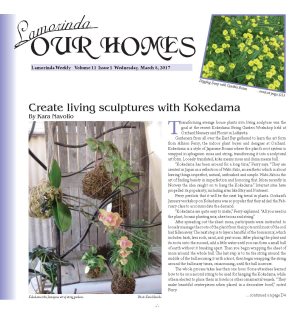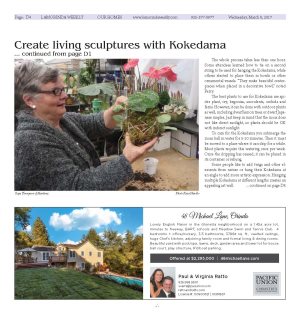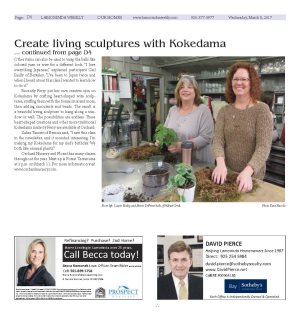| | Published March 8th, 2017
| Create living sculptures with Kokedama
| | | By Kara Navolio | 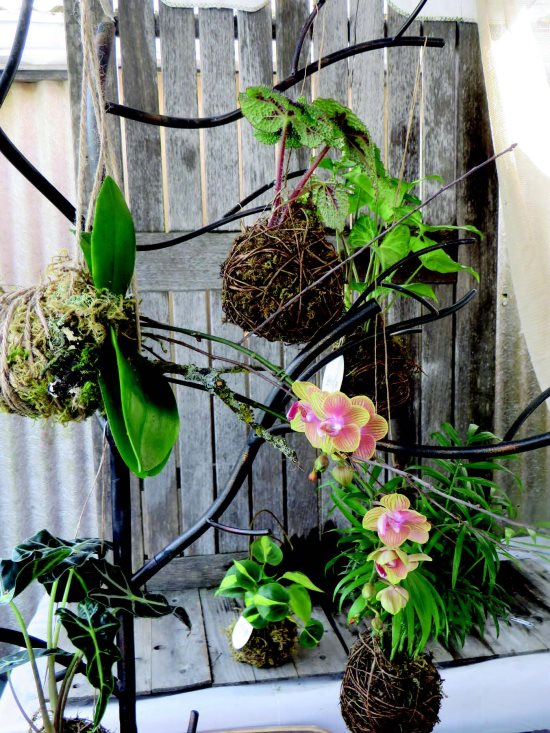 | | Kokedama i the Jamapnes art of string gardens. Photo Kara Navolio |
Transforming average house plants into living sculpture was the goal at the recent Kokedama String Garden Workshop held at Orchard Nursery and Florist in Lafayette.
 Gardeners from all over the East Bay gathered to learn the art form from Allison Ferry, the indoor plant buyer and designer at Orchard. Kokedama is a style of Japanese Bonsai where the plant's root system is wrapped in sphagnum moss and string, transforming it into a sculptural art form. Loosely translated, koke means moss and dama means ball.
Gardeners from all over the East Bay gathered to learn the art form from Allison Ferry, the indoor plant buyer and designer at Orchard. Kokedama is a style of Japanese Bonsai where the plant's root system is wrapped in sphagnum moss and string, transforming it into a sculptural art form. Loosely translated, koke means moss and dama means ball.
 "Kokedama has been around for a long time," Ferry says. "They are created in Japan as a reflection of Wabi-Sabi, an aesthetic which is about leaving things imperfect, natural, unfinished and simple. Wabi-Sabi is the art of finding beauty in imperfection and honoring that. More recently in Norway the idea caught on to hang the Kokedama." Internet sites have propelled its popularity, including sites like Etsy and Pinterest.
"Kokedama has been around for a long time," Ferry says. "They are created in Japan as a reflection of Wabi-Sabi, an aesthetic which is about leaving things imperfect, natural, unfinished and simple. Wabi-Sabi is the art of finding beauty in imperfection and honoring that. More recently in Norway the idea caught on to hang the Kokedama." Internet sites have propelled its popularity, including sites like Etsy and Pinterest.
 Ferry predicts that it will be the next big trend in plants. Orchard's January workshop on Kokedama was so popular that they added the February class to accommodate the demand.
Ferry predicts that it will be the next big trend in plants. Orchard's January workshop on Kokedama was so popular that they added the February class to accommodate the demand.
 "Kokedama are quite easy to make," Ferry explained. "All you need is the plant, bonsai planting mix, sheet moss and string."
"Kokedama are quite easy to make," Ferry explained. "All you need is the plant, bonsai planting mix, sheet moss and string."
 After spreading out the sheet moss, participants were instructed to loosely massage the roots of the plant from their pots until most of the soil had fallen away. The next step is to layer a handful of the bonsai mix, which includes bark, lava rock, sand, and peat moss. After placing the plant and its roots onto the mound, add a little water until you can form a small ball of earth without it breaking apart. Then you begin wrapping the sheet of moss around the whole ball. The last step is to tie the string around the middle of the ball securing it with a knot, then begin wrapping the string around the ball many times, crisscrossing, until the ball is secure.
After spreading out the sheet moss, participants were instructed to loosely massage the roots of the plant from their pots until most of the soil had fallen away. The next step is to layer a handful of the bonsai mix, which includes bark, lava rock, sand, and peat moss. After placing the plant and its roots onto the mound, add a little water until you can form a small ball of earth without it breaking apart. Then you begin wrapping the sheet of moss around the whole ball. The last step is to tie the string around the middle of the ball securing it with a knot, then begin wrapping the string around the ball many times, crisscrossing, until the ball is secure.
 The whole process takes less than one hour. Some attendees learned how to tie on a second string to be used for hanging the Kokedama, while others elected to place them in bowls or other ornamental vessels. "They make beautiful centerpieces when placed in a decorative bowl," noted Ferry.
The whole process takes less than one hour. Some attendees learned how to tie on a second string to be used for hanging the Kokedama, while others elected to place them in bowls or other ornamental vessels. "They make beautiful centerpieces when placed in a decorative bowl," noted Ferry.
 The whole process takes less than one hour. Some attendees learned how to tie on a second string to be used for hanging the Kokedama, while others elected to place them in bowls or other ornamental vessels. "They make beautiful centerpieces when placed in a decorative bowl," noted Ferry.
The whole process takes less than one hour. Some attendees learned how to tie on a second string to be used for hanging the Kokedama, while others elected to place them in bowls or other ornamental vessels. "They make beautiful centerpieces when placed in a decorative bowl," noted Ferry.
 The best plants to use for Kokedama are spider plant, ivy, begonias, succulents, orchids and ferns. However, it can be done with outdoor plants as well, including dwarf lemon trees or dwarf Japanese maples. Just keep in mind that the moss does not like direct sunlight, so plants should be OK with indirect sunlight.
The best plants to use for Kokedama are spider plant, ivy, begonias, succulents, orchids and ferns. However, it can be done with outdoor plants as well, including dwarf lemon trees or dwarf Japanese maples. Just keep in mind that the moss does not like direct sunlight, so plants should be OK with indirect sunlight.
 To care for the Kokedama you submerge the moss ball in water for 5-10 minutes. Then it must be moved to a place where it can drip for a while. Most plants require this watering once per week. Once the dripping has ceased, it can be placed in its container or rehung.
To care for the Kokedama you submerge the moss ball in water for 5-10 minutes. Then it must be moved to a place where it can drip for a while. Most plants require this watering once per week. Once the dripping has ceased, it can be placed in its container or rehung.
 Some people like to add twigs and other elements from nature or hang their Kokedama at an angle to add more artistic expression. Hanging multiple Kokedama at different lengths creates an appealing art wall.
Some people like to add twigs and other elements from nature or hang their Kokedama at an angle to add more artistic expression. Hanging multiple Kokedama at different lengths creates an appealing art wall.
 Other items can also be used to wrap the balls like colored yarn or wire for a different look. "I love everything Japanese," explained participant Gail Reilly of Berkeley. "I've been to Japan twice and when I heard about this class I wanted to learn how to do it."
Other items can also be used to wrap the balls like colored yarn or wire for a different look. "I love everything Japanese," explained participant Gail Reilly of Berkeley. "I've been to Japan twice and when I heard about this class I wanted to learn how to do it."
 Recently Ferry put her own creative spin on Kokedama by crafting heart-shaped wire sculptures, stuffing them with the bonsai mix and moss, then adding succulents and beads. The result is a beautiful living sculpture to hang along a window or wall. The possibilities are endless. These heart-shaped creations and other more traditional Kokedama made by Ferry are available at Orchard.
Recently Ferry put her own creative spin on Kokedama by crafting heart-shaped wire sculptures, stuffing them with the bonsai mix and moss, then adding succulents and beads. The result is a beautiful living sculpture to hang along a window or wall. The possibilities are endless. These heart-shaped creations and other more traditional Kokedama made by Ferry are available at Orchard.
 Zahra Tanner of Benicia said, "I saw this class in the newsletter, and it sounded interesting. I'm making my Kokedama for my dad's birthday. We both like unusual plants."
Zahra Tanner of Benicia said, "I saw this class in the newsletter, and it sounded interesting. I'm making my Kokedama for my dad's birthday. We both like unusual plants."
 Orchard Nursery and Florist has many classes throughout the year. Next up is Forest Terrariums at 2 p.m. on March 11. For more information visit www.orchardnursery.com.
Orchard Nursery and Florist has many classes throughout the year. Next up is Forest Terrariums at 2 p.m. on March 11. For more information visit www.orchardnursery.com.

|
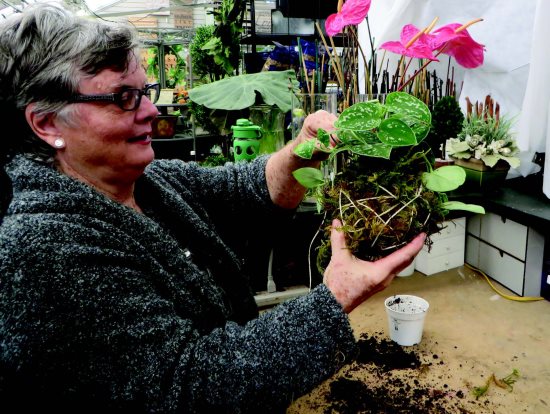 | | Gaye Thompson of Martinez. Photo Kara Navolio |  | | From left: Laurie Hailey and Merrie DeFrene both of Walnut Creek. Photo Kara Navolio | | | | | | | | | |





